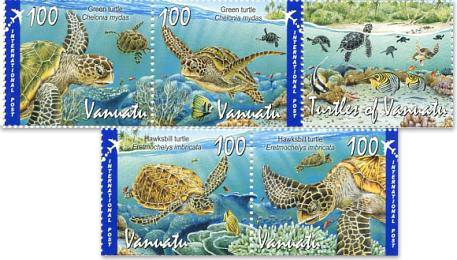Turtles of Vanuatu
-
Denominations :100 vatu x 4 stamps
-
Designer :J R Lisiak, Paris, France
-
Paper :104 gsm Tullis Russell gummed stamp paper
-
Perforation Gauge :13.3 x 2
-
Period of Sale :26 January 2011 for a period of 2 years
-
Printer :Southern Colour Print, Dunedin, New Zealand
-
Process :Offset lithography
-
Stamp Size :30.00mm x 40.00mm, 4 horiz. Stamps + tab
Description
The two most commonly found turtles in Vanuatu are the Hawksbill turtle Eretmochelys imbricata, and the Green turtle Chelonia mydas. The hawksbill turtle identified easily by a pointed, hooked beak, is relatively small, weighing around 60 kg. Its shell is about 90 cm, and has plates or scutes that overlap each other. It feeds mainly on soft coral, sponges, crustaceans and cephalopods. The green turtle is larger, weighing around 145 kg with a shell about 110 cm in length and plates that are well-separated. Young green turtles feed on algae and sea grass, adults mostly feed on small crabs and shellfish.
Fishermen and research scientists around the world have noticed a dramatic decrease in the numbers of sea turtles, which are considered to be in danger of extinction worldwide. According to the Convention on International Trade in Endangered Species Wild Fauna and Flora (CITES), all sea turtles are now considered endangered by international trade. Turtles of Vanuatu date stampIn Vanuatu populations have been decreasing and while groups such as SPREP and CITES have brought international focus on this situation, it is encouraging to see local Vanuatu programmes taking up the challenge. Turtle monitor village volunteers on Moso, Nguna and Pele islands on Efate’s north coast demonstrate how local communities are working hard to preserve these beautiful creatures. Tagging, monitoring and even satellite tracking are important components in the preservation process with information being collected and used to plan how to best monitor and manage the conservation of sea turtles in the archipelago. Commercial fishing, pollution, set nets and destruction of beach nesting areas are what these groups are up against apart from the traditional cultural reasons for harvesting and the struggle continues. With more enforced legislation; bans on taking turtles or eggs during the nesting season and the making of selling turtles or any by-products illegal, most Pacific countries are striving to protect these species.
Turtles of Vanuatu date stampIn Vanuatu populations have been decreasing and while groups such as SPREP and CITES have brought international focus on this situation, it is encouraging to see local Vanuatu programmes taking up the challenge. Turtle monitor village volunteers on Moso, Nguna and Pele islands on Efate’s north coast demonstrate how local communities are working hard to preserve these beautiful creatures. Tagging, monitoring and even satellite tracking are important components in the preservation process with information being collected and used to plan how to best monitor and manage the conservation of sea turtles in the archipelago. Commercial fishing, pollution, set nets and destruction of beach nesting areas are what these groups are up against apart from the traditional cultural reasons for harvesting and the struggle continues. With more enforced legislation; bans on taking turtles or eggs during the nesting season and the making of selling turtles or any by-products illegal, most Pacific countries are striving to protect these species.
Vanuatu Post supports such measures and releases this stamp issue to highlight the beauty and importance of these reptiles both now and for future generations.


